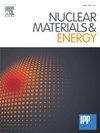Effects of 14 T high magnetic field on the formation and migration behavior of CLF-1 steel corrosion products
IF 2.7
2区 物理与天体物理
Q1 NUCLEAR SCIENCE & TECHNOLOGY
引用次数: 0
Abstract
The CLF-1 steel, which is a main candidate material of cooling water pipes in fusion reactor blanket being developed in China, is not only corroded by water, but also operates in high magnetic fields. The effect of magnetic field on the corrosion process of CLF-1 steel should be considered. Currently, the corrosion of fusion reactor materials in high magnetic fields at scales of 10 T has not been studied due to the lack of suitable experimental conditions for high magnetic fields. To study the influence of high magnetic fields on the corrosion process of CLF-1 steel, corrosion experiment was carried out using a superconducting steady-state magnet in 1 wt% H2O2 + 0.1 wt% NaCl solution for 2 h with the 14 T high magnetic field. A contrast experiment without the magnetic field was performed. The ANSYS software was used to simulate the distribution of magnetic flux around the sample in a 14 T magnetic field. The morphology of the samples was observed and the composition of corrosion products was analyzed. The number of corrosion pits on the sample surface increases significantly at 14 T magnetic field, and the surface corrosion products around the pits appear approximately circular in shape, while the corrosion products distributing in strip shape on sample corroded without the magnetic field. The simulations show that the maximum magnetic flux density is localized in the middle of the sample, where most of the corrosion pits are distributed. Possible reasons for the influence of the magnetic field on the corrosion process could be that the Lorentz force and magnetic gradient force induced change the motion of ions and paramagnetic substances (such as O2) respectively.
14t强磁场对CLF-1钢腐蚀产物形成及迁移行为的影响
CLF-1钢是中国正在开发的核聚变堆包层冷却水管的主要候选材料,它不仅易受水腐蚀,而且在强磁场下工作。应考虑磁场对CLF-1钢腐蚀过程的影响。目前,由于缺乏合适的高磁场实验条件,尚未对聚变反应堆材料在10 T尺度下的高磁场腐蚀进行研究。为了研究强磁场对CLF-1钢腐蚀过程的影响,采用超导稳态磁体在14t强磁场下,在1wt % H2O2 + 0.1 wt% NaCl溶液中腐蚀2h。进行了无磁场的对比实验。利用ANSYS软件模拟了样品在14t磁场下的磁通分布。观察了试样的形貌,分析了腐蚀产物的组成。在14t磁场作用下,样品表面腐蚀凹坑数量显著增加,凹坑周围表面腐蚀产物呈近似圆形分布,无磁场作用下腐蚀样品表面腐蚀产物呈条状分布。模拟结果表明,最大磁通密度分布在试样的中部,腐蚀坑分布在该区域。磁场对腐蚀过程产生影响的可能原因是,诱导的洛伦兹力和磁梯度力分别改变了离子和顺磁性物质(如O2)的运动。
本文章由计算机程序翻译,如有差异,请以英文原文为准。
求助全文
约1分钟内获得全文
求助全文
来源期刊

Nuclear Materials and Energy
Materials Science-Materials Science (miscellaneous)
CiteScore
3.70
自引率
15.40%
发文量
175
审稿时长
20 weeks
期刊介绍:
The open-access journal Nuclear Materials and Energy is devoted to the growing field of research for material application in the production of nuclear energy. Nuclear Materials and Energy publishes original research articles of up to 6 pages in length.
 求助内容:
求助内容: 应助结果提醒方式:
应助结果提醒方式:


